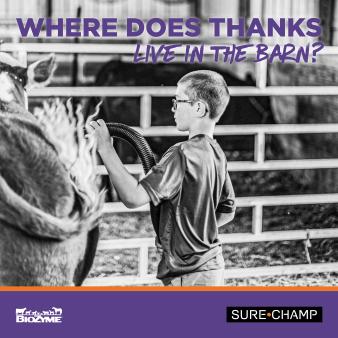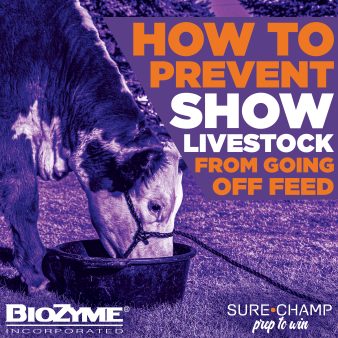
Most would agree that show calves live a fairly lavish life. They get a balanced meal twice a day, daily skin and hair treatments, exercise and are tied in under fans or in a cooler room most of the time. However, as the temperatures drop and show schedules change, so does some of the daily care. Livestock exhibitors need to be aware of how to prevent winter cold stress in cattle.
The Sure Champ team is passionate about our own show livestock, including our show cattle. We know that heat stress is often more common; however, as the cold, wet winter chill sets in, cold stress can also wreak havoc on our stock. Prevention is a much better option than treatment when it comes to management scenarios, so we want to share with you how to best prevent cold stress in cattle.
When does Cold Stress in Cattle Happen?
Cold stress in the winter is impacted when the ambient temperature, which considers both wind chill and humidity, drops below the lower critical temperature (LCT), when cattle lose the ability to withstand cold conditions. The LCT is the temperature at which maintenance requirements increase to the point where animal performance is negatively affected. Various sources put this temperature between 18 to 20 °Fahrenheit. The lower critical temperature is influenced by both environmental and animal factors including hair coat and body condition. Kansas State University provides a great chart that shows the variances in lower critical temperature when cold stress can occur based on hair coat, humidity and temperature.
Remember, your show calves will likely be more haired up than most cattle. However, it is important to follow these preventative guidelines to ensure that they do not experience cold stress.
3 Ways to Prevent Cold Stress in Cattle
We always want the best for our animals, and our show cattle are especially well taken care of. But cattle are hardy animals, so it can be easy to forget that cold stress in cattle is an issue. However, we’ve got a list of a few preventative measures to help keep your cattle warm during the cold months. Here’s what you need to do:
1. Provide Shelter & Bedding
The cold weather alone might not bother your cattle. It is a combination of temperature, wind and humidity—either rain, sleet or snow—that causes their temperature to drop. That is why it is vital to provide shelter or windbreak for your calves when they are turned out.
Perhaps just as important is to ensure they have a dry area to bed down on. Provide them with plenty of dry bedding, such as straw or corn stalks. The frozen ground or mud can intensify the critical temperature, adding to the cold stress they experience.
2. Ensure Your Calves are Dry
If you are preparing for a winter show, you are likely still rinsing your calves on an inside wash rack. It is imperative that your cattle are 100% dry before you turn them out. Cattle with a dry, clean haircoat do provide the best insulation against the cold. Calves with wet or even damp skin or hair will get chilled, potentially leading to sickness.
3. Supply Good Nutrition, Water
Water is often overlooked in the winter. Yet, it is the most important nutrient regardless of the season. Be sure your show cattle have access to thawed, fresh water throughout the day.
“Typically, water intake is directly correlated to dry matter intake. Cattle eat more when it’s cold, so usually they drink more as well. It’s a little backwards of what we’d typically think, but their water intake can be really high in these times of the year,” said Chris Cassady, Ph.D., Director of Beef Technical Sales.
A good rule of thumb for feeding during the cold is for every degree below the cow’s LCT, the temperature drops, you need to feed her an extra 1% of energy. So, if it’s 7 degrees below, that means she needs 7% more energy than normal. That’s where the benefits of AO-Biotics® Amaferm® can help prevent cold stress in cattle. Amaferm is a research-proven prebiotic designed to enhance digestibility and it helps with the overall absorption of nutrients.
“Volatile fatty acid production from Amaferm is increased 16%, and if 80% of that is used for energy, Amaferm alone can cover the energetic gap up to 11 degrees below the LCT. It reduces stress and keeps gut integrity in check,” Cassady said.
Since we know that 70% of the immune response starts in the digestive system, we know that a healthy gut leads to healthy animals, and healthier animals grow and perform better. Furthermore, if your animals’ digestibility is enhanced, that digestion will warm them from the inside.
Amaferm is a key ingredient in Sure Champ, a line of products that support the health and well-being of show livestock.
Sure Champ Can Help
Let’s explore Sure Champ products designed especially for cattle that can help with cold stress.
Sure Champ® Cattle is a pelleted, daily supplement with protein, vitamins and minerals for show livestock designed to support performance. It contains Amaferm, stimulates consistent appetite and ensures that cattle receive adequate vitamins and minerals.
Sure Champ® Cattle Drench is a drench for cattle designed to support digestive health before, during and after challenges. Formerly known as Vita Charge Cattle Drench, it contains enzymes that generate a more rapid digestive response. It also contains Amaferm and MOS (mannan oligosaccharides), which help normalize gut microflora and support the immune system.
Get Your Sure Champ Today
Show cattle nutrition is just one part of preventing cold stress in cattle. Sure Champ can be the basis of your nutrition program. It is important to provide them with dry, fresh bedding in a sheltered area out of the wind, too. Also, make sure they are completely dry when turned back out.
You can get your Sure Champ products as easily as ordering online today.
Do you prefer to support a local Sure Champ dealer? Find a dealer near you to find all your favorite Sure Champ and other BioZyme products.
Want to stay current on all of our educational blogs and news? Sign up for our newsletter.

